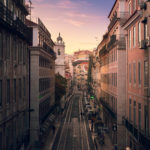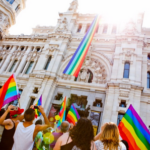A few days in Lisbon is enough to whet one’s appetite for more of this vibrant, stylish, culinary-dense, historic and trendy city. It’s also in the forefront of Gay Life in Europe.
By Richard Ammon
GlobalGayz.com
March 2015
(most photos by GlobalGayz.com)
Lisbon is alive with countless cafes serving up a thousand menus of pastries, espresso, sea food–indeed, any and every type of edible swimmer from squid to prawns, all fish, clams and lobsters. Along the noisy cobblestone streets run luxury sedans, sports cars, motorcycles, tourist-laden tuk-tuks, buses, trolley cars, long yellow city buses, and endless tourist vans and buses. Pedestrian-only streets are scattered across the city, up an down the seven hills. 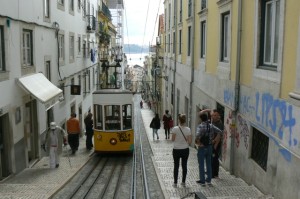 The enormous passenger and cargo port disgorges goods and visitors among the towering cathedrals, basilicas, parish churches, hilltop fortress, museums, charming local plazas and countless luxury hotels and small hostels with 10×10 rooms. The streets are alive with restless foot and motor traffic. There is so much to see, looking up at the hill-hugging castle walls, looking down from on high to the enormously wide River Tejo that has issued forth explorer ships since the 15th century to colonize great swaths of foreign territory for the now-defunct throne of Portugal.
The enormous passenger and cargo port disgorges goods and visitors among the towering cathedrals, basilicas, parish churches, hilltop fortress, museums, charming local plazas and countless luxury hotels and small hostels with 10×10 rooms. The streets are alive with restless foot and motor traffic. There is so much to see, looking up at the hill-hugging castle walls, looking down from on high to the enormously wide River Tejo that has issued forth explorer ships since the 15th century to colonize great swaths of foreign territory for the now-defunct throne of Portugal.
It’s a different story in the vast manicured and angular suburbs surrounding Lisbon where thousands of high rise condo towers are vertically stacked like lego cities housing indigenous people from Portugal as well as immigrants from former Portuguese colonies such as Brazil, Cape Verde, Mozambique, Angola, Guinea-Bissau, Goa (India), São Tomé and Príncipe (Africa), Macao (China), East Timor, and Malacca (Malaysia). The Portuguese got around!
Historically these colonies started as trading posts for merchandise that tragically included kidnapped slaves, a lucrative business that enriched a few and robbed countless others of their homes in Africa. “From 1580 to the 1820s, well over a million people from current-day Angola alone were exported as captured slaves to the so-called New World, mainly to Brazil, but also to North America,” as one guide described it. Unarmed, innocent and naive natives were taken from their villages and forced into bondage and sent abroad to work like animals never to see their villages and families again.
Modern downtown Lisbon reveals nothing of Portugal’s vast empire or its abhorrent cruelty to black Africans. Indeed, every western European country has a dark shadow of imperialism and abuse beyond its borders. Few if any of today’s leisure tourist class buzzing from museum to church to monument to cafe are aware of either of these significant past episodes and epochs. It is a busy city that’s easy to like.
Important Digression Into History
The history of overseas Portugal is not a settled one; it encroached upon foreign lands with trading posts and mercantile companies, built railroads, disrupted native cultures that often set off consequent guerrilla warfare and massacres. All this was simultaneous with the more peaceful yet equally invasive Christian religious orders that invalidated pagan and spiritualist traditions but also sponsored schools and health centers as well as parish churches.
Exploration by Portuguese sailors and adventurers during the 15th and 16th centuries into unknown territories ‘discovering’ coastlines along Africa, Asia and as far west as Braz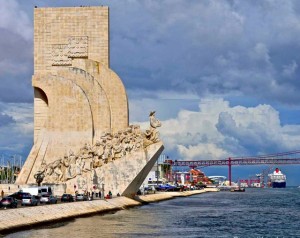 il–as if no natives lived there. The times were dubbed the ‘Age of Discovery’ by subsequent blinkered historians. Methodical measurements and drawings started in 1419 first along West Africa’s coast under the patronage of Portuguese ‘hero’ prince Henry the Navigator. (photo left: Lisbon Monument to Discovery with Henry at the helm)
il–as if no natives lived there. The times were dubbed the ‘Age of Discovery’ by subsequent blinkered historians. Methodical measurements and drawings started in 1419 first along West Africa’s coast under the patronage of Portuguese ‘hero’ prince Henry the Navigator. (photo left: Lisbon Monument to Discovery with Henry at the helm)
Many ships were launched that never returned home but others did including Bartolomeu Dias who reached the stormy sea-tossed African Cape of Good Hope. Battered and bruised but undaunted Dias and his crew, in 1488, found an enormous waterway now known as the Indian Ocean. Building on this effort ten years later Vasco da Gama captained the first small fleet around Africa all the way to India to Calicut (Kozhikode on the west coast) thus opening a maritime path from Portugal to India, a journey of 9089 kilometers. Within a half century the Portuguese reached Brazil, southeast Asia and Japan, in 1542.
It is of no small significance that the rise and domination of the Portuguese over much of the known world was directly due to its practical application of ‘celestial navigation’, a system of using or ‘measuring’ the sun, moon and stars to guide ships on the vast open seas using a chronometer, a sextant and a logbook almanac. Nautical charts and textual descriptions had been in use in one form or another since the sixth century BC but the Portuguese advanced and perfected that navigational skill to great imperialist advantage.
Eventually, after four hundred years of not always calm occupation, declining world opinion and dwindling wealth the tides and times turned against Portuguese occupations and finally led to the Carnation Revolution in 1974 in Lisbon that initiated independence in former Portuguese colonies.
(photo right: Portuguese flag)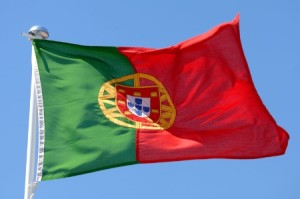
The Pulse of Today
Portugal is much humbled today from its vast imperial empire of the past but there are plenty of stirring remnants for a modern visitor to see such as huge castles, massive city walls, miles of aqueducts, renaissance universities, Stonehenge-like ancient monoliths and funerary dolmens, Roman ruins, huge monasteries and cathedrals and of course the land itself with rocky peaks, verdant fields and rugged coastlines. Indeed, at the Lisbon harbor there is a huge sculpted granite ‘Monument to the Discoveries’ that commemorates the long epoch of Portuguese explorations.
An important aspect of this tiny country (about the size of the US state of Maine) is its current–if fragile–economy, its laissez-faire milieu and its valuation of freedom and opportunity. For almost half of the twentieth century Portugal was tightly controlled by the dictatorship of Antonio Salazar and shadowed by the nearby fascist threats of Spain’s Franco, Italy’s Mussolini and Germany’s Hitler, none of whom tolerated dissent or freedom of speech, let alone sexual varieties.
Under all these brutal regimes homosexuality was outlawed and LGBT citizens were persecuted. Salazar ran the country from 1932 to 1968 after overthrowing an ineffective but elected government in 1926. (The nearly 800 year old monarchy was dismissed in 1910.) Many still revere him for stabilizing the fragile economy and keeping the country mostly out of World War II. But he ruled with a secret police force that tortured opponents and maintained widespread censorship and suppression of cultural expression. Homosexuality was first decriminalized in 1852, but that was reversed in 1886 and finally re-legalized in 1982. Today it is one of the few countries in the world whose constitution bans discrimination against citizens on the basis of sexual orientation and since June 2010 the country became the eighth in the world to legally approve same-sex marriage. Everything changes.
My time in Portugal included a drive around the country, from the rugged southwest coast past the 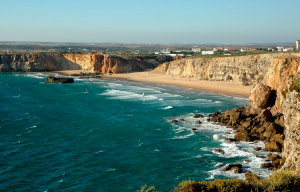 condos and beaches of the Algarve north to the snowy Serra da Estrela mountains and down the west coast from Porto to Lisbon. Each destination was a collage of ancient and modern life from sprawling city suburban condo jungles to old world castles and windmills to charming pastry cafes, chic seafood restaurants, narrow cobblestone alleys and plenty of tourists. (photo left: Atlantic cliffs in Sarges)
condos and beaches of the Algarve north to the snowy Serra da Estrela mountains and down the west coast from Porto to Lisbon. Each destination was a collage of ancient and modern life from sprawling city suburban condo jungles to old world castles and windmills to charming pastry cafes, chic seafood restaurants, narrow cobblestone alleys and plenty of tourists. (photo left: Atlantic cliffs in Sarges)
Gay in Public
My contact with gay Portugal was public and private. I noticed young gay people seem to be more bold; we saw millennials (Gen Yers) display their affection in public without looking around. First a twenty-something pair of guys in hip clothes and a couple of tattoos walking in the Baixa area of trendy cafes and coffee bars suddenly felt a surge of desire and turned to each other to exchange a passionate wet kiss briefly without stopping and continuing on their way. I couldn’t be certain they were Portuguese but it’s unlikely a foreign couple would embrace so easily on a main street in a foreign country. Apparently these guys felt comfortable and fearless enough to do a brief lip lock knowing their culture (central city, educated, liberal mid-to-upscale) would and could absorb a brief flicker of alternative love.
I sensed the same when another couple, two young lesbians, vigorously grabbed and hugged each other on a railway platform as one of them stepped off the train. I had been sitting one seat across from the arriving one, a young-twenty-something, fey, androgynous, butch-d ressed girl on her way to meet her Ms Right. At first I couldn’t tell whether this was a fem male or a tomboy sitting in red jeans and plaid shirt talking into a blue cell phone and nervously nibbling on her fingernails all the while. A little more close study of her features, soft facial skin, no sign of whiskers, smooth lips and when she moved a slightly breasted upper torso defined her womanhood, which she seemed to want to mask.
ressed girl on her way to meet her Ms Right. At first I couldn’t tell whether this was a fem male or a tomboy sitting in red jeans and plaid shirt talking into a blue cell phone and nervously nibbling on her fingernails all the while. A little more close study of her features, soft facial skin, no sign of whiskers, smooth lips and when she moved a slightly breasted upper torso defined her womanhood, which she seemed to want to mask.
Then on arrival she was quickly out the door and into the arms of her more fem girlfriend with long brown hair waiting for her on the platform. It was clear these were not casual friends off to the library for a school project. They turned and walked into a clear view of my camera lens. This quick scene was not in central city but rather in the suburbs, definitely not among tourists passing by. I wouldn’t call them courageous, rather naturally bold gen-x kids who knew their culture and felt assured and unafraid to express their manner of affection in public.
These two couples were in contrast to the several other obviously gay and lesbian couples I spotted during our visit to the fabulous castles and mansions in the forested hills of Sintra (a tourist mecca just west of Lisbon). These older foreigners did not hold hands or kiss in public. No doubt because they came from cultures where negative attitudes toward gay love influenced their public demeanor to keep their displays of affection in check. None of the ‘foreign’ couples even held hands, including yours truly. It’s not something we do in other countries having seen and read about the risk of homophobic disapproval or abuse.
Another accide ntal view of a same-sex tryst, of sorts, was in a subway station where two young men stood away from the cluster of waiting passengers, half hidden in a wall niche. As the train pulled in they slipped further into the niche to exchange a brief departing kiss, longer than a peck on the cheek but not a sloppy wet one, then separated toward separate directions. This quickie was no surprise to me after a few days in Lisbon; it was another refreshing flash of unabashed affection in this Catholic-drenched yet liberated city.
ntal view of a same-sex tryst, of sorts, was in a subway station where two young men stood away from the cluster of waiting passengers, half hidden in a wall niche. As the train pulled in they slipped further into the niche to exchange a brief departing kiss, longer than a peck on the cheek but not a sloppy wet one, then separated toward separate directions. This quickie was no surprise to me after a few days in Lisbon; it was another refreshing flash of unabashed affection in this Catholic-drenched yet liberated city.
Behind the Scenes
Getting gay marriage passed in a very Catholic country is no easy feat. It takes political savvy, inside connections, articulate arguments, lobbying legislators, empowering a grass roots organization, persistence, hutzpah and courage. That’s what the folks at the ILGA-Portugal gay organization did to push the parliament beyond conservative resistance and religious homophobia to victory when gay marriage was approved in Portugal. At the time it was only the 8th country in the world to do so.
Two members of ILGA-Portugal, Paulo Côrte-Real and Miguel Vale de Almeida, among others, were driving forces behind this successful cultural achievement that
was approved by parliament on 8 January 2010 and became law 5 June 2010.
Our first words had to do with selecting a talking place. There are so many cafe choices in central Lisbon, each shamelessly flaunting a mouth-watering display of pastries, chocolates, fruitcakes, cookies and of course, everywhere, Pasteis de Nata (cream tarts), a pastry custard cup. Choosing cafes to meet my hosts (separately on different days) was easy; each picked one of their favorites.
The marriage movement initially started in 2004 when a lesbian couple applied for a license and were refused despite anti-discrimination protections that were added in 2004 to the 1976 constitution that included sexual orientation. The women then sued the local marriage bureau which upset the status quo and the issue went public which led to political jockeying, back room arm twisting, a 5000-person strong anti-marriage rally and the personal disapproval of the Pope. Nevertheless the Socialist government approved the bill creating a dramatic media sensation and outcry from traditionalists who said society was doomed. As usual, that soon faded as do most hysterics.
Miguel was first, at Cafe Pão de Canela) on the quiet backstreet Park of Flowers (Praça das Flores). Miguel Vale de Almeida (photo left) appeared more like a rugby player than an intellectual 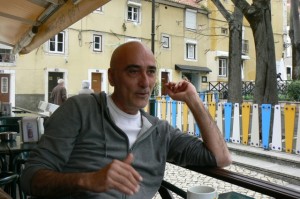 effete and political maverick. Miguel was a member of parliament with considerable skill of persuasion among his peers and helped bring the marriage law into effect. He described how he cornered and cajoled undecided parliament members to support the bill. “I made them see me as a person, as a parent, as a citizen of equal value. I was not threatening to take Portugal down the road to moral decay. I was real; I was a good citizen; I was one of them,” he said, describing his manner of persuading other MPs who had never dealt with gay people before and were understandably ignorant of the injustice and discrimination being perpetrated against them.
effete and political maverick. Miguel was a member of parliament with considerable skill of persuasion among his peers and helped bring the marriage law into effect. He described how he cornered and cajoled undecided parliament members to support the bill. “I made them see me as a person, as a parent, as a citizen of equal value. I was not threatening to take Portugal down the road to moral decay. I was real; I was a good citizen; I was one of them,” he said, describing his manner of persuading other MPs who had never dealt with gay people before and were understandably ignorant of the injustice and discrimination being perpetrated against them.
During lunch the next day with Paulo Côrte-Real at the famous Brasileira Cafe on the main plaza of the Biaxa-Chiado district, I spoke quietly with him about this remarkable achievement.
At the same time as Miguel was working inside parliament, Paulo and trained lobbyists from ILGA-Portugal worked the halls of the capitol building from outside the government. They had identified key legislators as potential allies in the crucial few months before the vote. Both Paulo and Miguel were well equipped for the contest; both are PhD scholars and experienced leaders in gay advocacy in Lisbon with no small mastery of political strategy, argument and persuasion.
Paulo (photo right) and I reflected on the speed of gay marriage approval in Portugal. The bill was introduced for debate in December 2009, passed by the National Assembly in January 2010, declared legally valid by the Portuguese Constitutional Court in April, ratified on 17 May 2010 by President Aníbal Cavaco Silva and became effective on 5 June 2010. This was followed in March 2011 by the President signing the Law of Gender Identity said to be the most advanced in the world at that time (Argentina’s new law goes further). which simplifies the process of sex and name change for transsexual people. At that time Paulo was president of ILGA-Portugal and along with Miguel led the lobbying and advocacy charge.
Brasileria Cafe has high coffered ceiling, tile floors, rich wood cabinets and long bar, mirrors and chandeliers and served fast gourmet food for lunch and diner. It is also designated as ‘gay friendly’ but who can tell the difference with hundreds of custome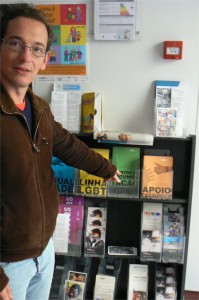 rs in and out every day. We three gay boys, Paulo, my partner Michael and I, captured a quiet corner table to avoid the swirl of tourists and ordered the plat du jour (typically fish) as we talked about the state of Portugal’s fragile economy, it’s excellent system of highways, and high taxes which are about 50% (and includes health insurance for all).
rs in and out every day. We three gay boys, Paulo, my partner Michael and I, captured a quiet corner table to avoid the swirl of tourists and ordered the plat du jour (typically fish) as we talked about the state of Portugal’s fragile economy, it’s excellent system of highways, and high taxes which are about 50% (and includes health insurance for all).
Paulo and Miguel are both university professors in Lisbon. Paulo is the former president of ILGA-Portugal and is still active in their programs. He explained some of the support programs that ILGA-P offered to the gay community as well as outreach seminars to non-gay groups such as police and first responders.
Reflecting on their victory, Paulo suggested that an unanticipated influence on the Portuguese parliament came from Spain where the Catholic church had its fingers burned in defeat when the secular congress there, partially to counteract the over-zealous church opposition and attempted interference in government affairs, had approved gay marriage in July 2005. The Spanish church had protested too much. Paulo felt the church in Portugal, as a result, took a softer anti-gay stance to avoid another embarrassing thrashing.
As well, Paulo gave much credit to the ILGA-P center in Lisbon which mounted a serious lobbying effort aimed at legislators. “Like Miguel we recognized the value of personal contact with legislators so that’s where we put our efforts, talking to them in person. It’s easy for our opponents (or those indifferent to us) to demonize and hang negative labels on us in general, in an abstract way. But it’s different story when we meet eye-to-eye and they see us as real people just like them and explain our ideas and tell our stories. I think that a big difference for them was to see us as individuals and as families with children”
Then and now this approach disarmingly undermines the common stereotypes of homosexuality that are grounded in the larger Catholic culture where most attitudes toward religion, politics and sexuality are formed invisibly, insidiously and in blindly over decades and centuries. Homosexuality in Portugal and other Christian (and Muslim and Jewish) societies have morphed the issue of moral and pleasurable sexuality into a shame-based attribute not open for public debate or education. Ignorant rumors and generalized assumptions have calcified this most basic human behavior into a dark and rigid carnal wrong, fit only for midnight married heterosexual trysts in bed clothes.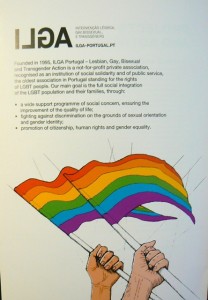
But people like Paulo and Miguel and dedicated members of ILGA-Portugal could not disagree more.
As a result of this personal-contact tactic sufficient MPs were persuaded to peel back their presumptions about homosexuals as weird sex-driven cultists who want to destroy heterosexual marriage with their agenda. “The plan was to show ourselves as very similar to them in values, lifestyle and citizenship,” Paulo repeated.
During his tenure at the Center significant changes happened. Importantly, the physical move of the Center from a derelict area of town to a more modern venue in the center of the city with a full agenda of activities that move beyond politics to more personally rewarding activities.
Gay bashing and violence is minimal, not because the majority Catholic straight community has turned liberal, but federal legal structures and community based activism have permeated the cultural ethos to raise awareness of human rights and outreach programs to authorities such as police, firefighters, EMTs, military, industrial and educational institutions. They continue to inform non-gay people about the occurrence, identity, nature and rights of LGBT citizens.
LGBT-Portugal Gay Center (known as Centro LGBT)
Away from the dancing, drinking and music there is the much calmer ILGA-Portugal, the largest and most active LGBT support and advocacy organization in the country. Paulo invited me to see the Center in downtown Lisbon. It is a modest beehive of activity decked out in rainbow colors. Some of the most important strategy and policy happened here in 2009-10 when plans were set to push for gay marriage described above.
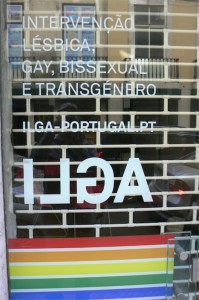 Now that marriage and gender identity equality are legalities the Center is still busy with its regular functions to make the laws real every day among the larger mostly non-gay population. The Center is “an institution of social solidarity and of public service whose main goal is full social integration of the LGBT population and their families through social support services, combating homophobia and promoting citizenship, human rights and genre equality.” (from their brochure ‘Igualdade’).
Now that marriage and gender identity equality are legalities the Center is still busy with its regular functions to make the laws real every day among the larger mostly non-gay population. The Center is “an institution of social solidarity and of public service whose main goal is full social integration of the LGBT population and their families through social support services, combating homophobia and promoting citizenship, human rights and genre equality.” (from their brochure ‘Igualdade’).
Being out, around and proud is easy after a certain age and after forming new families based on friendship and love and after becoming part of the Community and advocating for LGBT rights, or not, and living fully in the Portuguese society without fear or shame–and knowing that national laws protect the right to do so. But there are and always be the young newcomers in their teens who re-live the awkward threshold of coming out and accepting their orientation. These are the community of tomorrow who will carry the rainbow flag of progress.
It is for this generation of ever-new LGBTs that the Center offers crucial support and validation through its social and psychological services both in Lisbon and the northern city of Porto (second largest city in Portugal). In this way the Center works within our community with such activities such as sports groups, CoLeGaS choral group (of which Paulo is a member), hiking, parents groups, Brigada health classes to prevent HIV and STDs, theatre outings, trans support group, GIR@S walkers group, GRIT transsexual support services and individual counseling with volunteer professionals–as well as fun parties.
Outreach to the general population (including police, guards foreign offices, parents of LGBTs, teachers, university administrators, immigrant agencies) with educational seminars about LGBT issues (families, hate crimes, homophobia, equal treatment, bullying, harassment). As well, the Center has an available archive of research materials on homosexuality, history, social phenomenology for casual readers and serious researchers. The Center also trains volunteers to run the telephone hotline ‘Linha LGBT’ which offers many hours per week for information, compassion and referrals to professional care givers, free of charge, including the Center’s individual and group therapy sessions (called SAP).
Paulo also observed a new generation of LGBT young people changing the face and stride of gay Europe including gay Portugal. Gay perceptions inside and outside the community are more defined and less shame-based. There is more ‘out visibility’ than ever before; the closet is old school for these youngsters as the media and social networking include wider diversity of lifestyles, more secular and unbound by religious traditions.
‘Family’ is gaining a new meaning that is not limited to genetics and blood (although many young and not so young people live in a multi-generational home with parents and siblings). More recently many LGBT people now have ‘families of choice’. Love and affection and sometimes shared parenting with intimate friends are valid bonds for new families. Paulo and Miguel consider each other as an emotional part of their chosen family, which also includes two lesbian women and a child. They are not alone in this selection process as a new generation of European LBGTs expand the definition of marriage and family beyond the old bi-polar definition of one-man-one-woman-with-kids.
The most fun in the Center happens each year as it o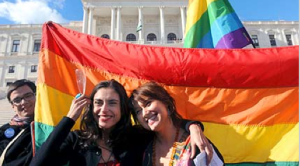 rganizes the Arraial (village) Lisboa Pride Festival (no parade) in the city’s central plaza, historic Commerce Square on behalf of diversity and equality. It’s a big village party fest.
rganizes the Arraial (village) Lisboa Pride Festival (no parade) in the city’s central plaza, historic Commerce Square on behalf of diversity and equality. It’s a big village party fest.
Also, each year in January the Center present ‘Rainbow Awards’ (Arco-iris) to outstanding people or institutions in Portugal for their exceptional support and advocacy of equality in the struggle against discrimination.
The Center has four paid staff and many volunteers who keep the Center vibrant, contemporary and visible with all of the above activities. It’s never dull, always vigilant and protective of human rights. It’s a small place but carries a big stick of influence in keeping LGBT issues, energy and public events alive year round.
Gay Map and Scene
Fortunately for me, or not, I am not a scene dweller and rarely go to a gay bar, club, sauna or party. So I have no personal tales to tell of late night gay Lisbon in happening places. However I read a lot and I have in my hand a useful ‘Gay Guide Lisbon’ in living color that lists about two dozen major venues in picture ads.
On the reverse side there are two neighborhood maps locating the hot spots. There is also a list of more than 50 gay and gay friendly venues including bars, cafes, dance clubs, saunas, tour companies, massage parlors, clothing stores, restaurants, hotels, LGBT groups, sex cinemas, sex shops and health clinics. More than enough to provide a holiday or home scene. And, in the warm weather, there is popular gay/nude beach (Beach 19) to chill out or beat around the bushes. Bottom line: there is as much LGBT scene here as any major European city.
LGBT Film Festival
Separate from the Center, Lisbon is also host to one of the largest LGBT film festivals in Europe, Queer Lisboa, the Lisbon Gay & Lesbian Film Festival. It is dedicated exclusively to screening gay, lesbian, bisexual, transgender, and transsexual themed films, a genre known as Queer Cinema. “Our purpose is that of programming the most aesthetically and narrative wise relevant titles in the international panorama, so that our audience has access to a number of films whose visibility in the film circuit is very restricted. Queer Cinema is an integral part of Film History.” The festival usually happens in September of each year.
(http://queerlisboa.pt/en/festival)
Finally
What’s left to say? Lesbian, gay, bisexual and transgender rights and life in Portugal have improved substantially in the past decade and are now among the best in the world.
Other sites about Portugal:
http://www.golisbon.com/culture/people.html
See more for Lisbon guides:
https://www.facebook.com/pages/Lisbon-Gay-Guide/192779157417985?fref=ts
https://www.facebook.com/Beach19
http://dezanove.pt/185442.html
http://www.lisbonbeach.com/lisbon-gay-guide.html
http://www.patroc.com/lisbon/
http://www.travelgayeurope.com/destination/gay-lisbon/

